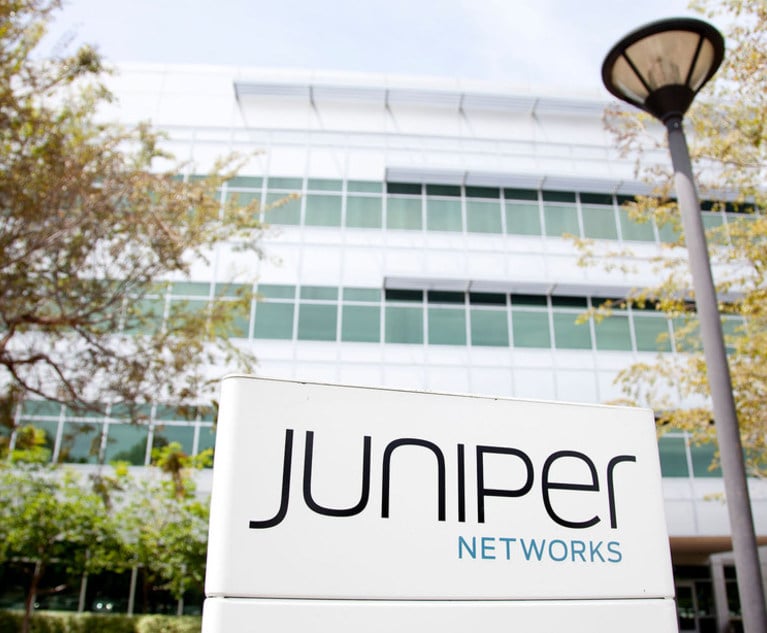AIA provides new ways to challenge issued patents
Three new quasi-litigation challenge procedures are now in effect
November 27, 2012 at 07:00 PM
7 minute read
For any business worried about infringing another's patent, life has gotten better … and more complicated. Thanks to the America Invents Act (AIA), businesses have a new and improved set of options for challenging the validity of issued patents.
“There are four different ways to challenge a patent [before the U.S. Patent and Trademark Office (PTO)], and they all have distinct advantages and disadvantages,” says Marc Kaufman, a partner at Reed Smith. He adds that any business wishing to challenge a patent needs to consider many factors and then make a
“strategic decision” about which PTO challenge to bring or whether to instead challenge the patent in court.
The new set of PTO challenges went into effect Sept. 16. Three of these challenges—inter partes review, post-grant review and the transitional program for covered business method patents—are novel, quasi-litigation procedures that panels of three PTO administrative law judges oversee. The fourth type of challenge, ex parte re-examination, has been in place for years but has now become more costly for challengers.
All this creates a major change for patentees and those challenging patents. “It is a whole new world,” says Lori Gordon, a partner at Sterne, Kessler, Goldstein & Fox.
Cheap and Easy
Ex parte re-examination offers the cheapest and easiest way to challenge a patent. Any time after a patent issues, a challenger simply files appropriate papers with the PTO, providing evidence that the patent was anticipated by earlier patents or printed publications. Then a patent examiner takes over the investigation and makes a determination, without the need for the challenger to do any additional work.
The challenger's freedom from involvement, however, can also be a significant drawback. “You can't advocate for your position, so you are relying on the examiner,” says Wab Kadaba, a partner at Kilpatrick Townsend & Stockton. “If your petition is strong enough, the proceeding can be particularly productive, but the inability to advocate is a major disadvantage.”
Moreover, ex parte re-examination isn't as cheap as it used to be. The filing fee has jumped from $2,520 to $17,750 (per challenged patent). Nevertheless, re-examination remains “far less expensive” than any other method of attacking a patent, Gordon says. And there's no estoppel, so if the re-examination upholds the patent, a challenger can still present the same validity attack in another proceeding.
Like ex parte re-examination, inter partes review can only be used for an anticipatory challenge based on patents or printed publications. Unlike re-examination, however, inter partes review requires a challenger to participate in a process that is akin to litigation. There are declarations by experts, depositions of experts, limited discovery, scheduling orders and a trial conducted before a panel of three administrative law judges of the PTO's new Patent Trial and Appeal Board.
Participating in such a proceeding isn't cheap. However, because discovery is limited and the proceedings are streamlined, inter partes review should still be significantly cheaper than district court litigation, according to experts.
Inter partes review should also be faster than litigation. Almost all inter partes reviews will be decided within 12 months, according to the PTO. By contrast, patent litigation typically runs two-and-a-half years before a trial is held, according to a 2012 PricewaterhouseCoopers study.
Inter partes review can only be initiated at certain times, however. A challenger cannot seek this review during the first nine months after a patent has issued, nor so long as there is an ongoing post-grant review of the patent. Once a party has filed a civil action attacking a patent's validity, that party cannot seek inter partes review of the patent. Finally, a party that is being sued for infringing a patent can seek inter partes review of that patent—but can do so only within one year of being served with the infringement complaint.
If a challenger loses an inter partes review, it is estopped from thereafter raising any issue that was raised or could reasonably have been raised in the proceeding. This estoppel applies to later proceedings before the PTO, the International Trade Commission or the courts. Thus, prior to filing for inter partes review, a challenger needs to “make a very deliberate decision as to which forum to choose” for a validity challenge, Kadaba says.
Plan Carefully
Post-grant review is similar to inter partes review but enables a much broader range of challenges. “You can raise any grounds of invalidity, including inadequate description, patent ineligible subject matter and anticipation evidenced by any type of prior art,” says Matthew Kreeger, a partner at Morrison & Foerster. “You can raise all sorts of arguments that you couldn't raise before except in litigation.”
This breadth of available challenges has a downside, however. It creates a correspondingly broad estoppel, covering any claim of invalidity that was raised or reasonably could have been raised in the proceedings.
This estoppel would, in most cases, prevent a challenger from attacking the patent in any other proceedings. So a business needs to plan carefully before seeking post-grant review. “You need to make sure you raise all your strongest invalidity attacks,” Kadaba says.
A challenger can seek post-grant review only during the first nine months after a patent has issued. However, no one can seek such a review yet. Although post-grant review technically went into effect Sept. 16, the process can only be used against patents arising from applications filed on or after March 16, 2013. Because patent prosecution typically lasts two-and-a-half to four years, it will be quite a while until a significant number of patents are eligible for post-grant review.
Unclear Definition
The transitional program for covered business method patents provides a particularly advantageous way to attack certain financial method patents. It can be used against any “patent that claims a method or corresponding apparatus for performing data processing or other operations used in the practice, administration, or management of a financial product or service,” the AIA states. But what is a financial product or service? Does it include anything enabling a financial transaction, such as a method of collecting money for online ads? “The definition is unclear,” Kaufman says.
The AIA adds an additional ambiguity. It excludes from the program all “patents for technological inventions.” The AIA explains that such an invention “as a whole” must solve “a technical problem using a technical solution” by using “a technological feature that is novel and unobvious over the prior art.” There will be plenty of battles over what that means, experts predict.
When this program applies to a patent, it allows the patent's validity to be challenged on any basis (similar to post-grant review). Unlike in post-grant review, a challenger faces estoppel only for issues actually raised in the proceeding. This is a boon for challengers. “If a challenger raises reference A in proceeding, it can still thereafter raise reference B, a combination of references A and B, and arguably even portions of reference A that were not raised in the proceeding,” notes Kaufman. This program “is a very desirable way to challenge a patent,” he adds.
But not everyone can use this program. It is available only if the entity filing the challenge has been sued for infringing the challenged patent or has a reasonable fear of being sued, according to experts.
For now, businesses can use this program can be used to challenge existing patents and new patents (as soon as they issue). However, a patent arising from an application filed on or after March 16, 2013, can't be challenged under this program until nine months after the patent has issued. Finally, this program sunsets Sept. 16, 2020, so any business that wants to take advantage of this promising method of attack must file before that date.
This content has been archived. It is available through our partners, LexisNexis® and Bloomberg Law.
To view this content, please continue to their sites.
Not a Lexis Subscriber?
Subscribe Now
Not a Bloomberg Law Subscriber?
Subscribe Now
NOT FOR REPRINT
© 2025 ALM Global, LLC, All Rights Reserved. Request academic re-use from www.copyright.com. All other uses, submit a request to [email protected]. For more information visit Asset & Logo Licensing.
You Might Like
View All
'A Warning Shot to Board Rooms': DOJ Decision to Fight $14B Tech Merger May Be Bad Omen for Industry

Exits Leave American Airlines, SiriusXM, Spotify Searching for New Legal Chiefs
2 minute read
'Incredibly Complicated'? Antitrust Litigators Identify Pros and Cons of Proposed One Agency Act
5 minute readTrending Stories
- 1Uber Files RICO Suit Against Plaintiff-Side Firms Alleging Fraudulent Injury Claims
- 2The Law Firm Disrupted: Scrutinizing the Elephant More Than the Mouse
- 3Inherent Diminished Value Damages Unavailable to 3rd-Party Claimants, Court Says
- 4Pa. Defense Firm Sued by Client Over Ex-Eagles Player's $43.5M Med Mal Win
- 5Losses Mount at Morris Manning, but Departing Ex-Chair Stays Bullish About His Old Firm's Future
Who Got The Work
J. Brugh Lower of Gibbons has entered an appearance for industrial equipment supplier Devco Corporation in a pending trademark infringement lawsuit. The suit, accusing the defendant of selling knock-off Graco products, was filed Dec. 18 in New Jersey District Court by Rivkin Radler on behalf of Graco Inc. and Graco Minnesota. The case, assigned to U.S. District Judge Zahid N. Quraishi, is 3:24-cv-11294, Graco Inc. et al v. Devco Corporation.
Who Got The Work
Rebecca Maller-Stein and Kent A. Yalowitz of Arnold & Porter Kaye Scholer have entered their appearances for Hanaco Venture Capital and its executives, Lior Prosor and David Frankel, in a pending securities lawsuit. The action, filed on Dec. 24 in New York Southern District Court by Zell, Aron & Co. on behalf of Goldeneye Advisors, accuses the defendants of negligently and fraudulently managing the plaintiff's $1 million investment. The case, assigned to U.S. District Judge Vernon S. Broderick, is 1:24-cv-09918, Goldeneye Advisors, LLC v. Hanaco Venture Capital, Ltd. et al.
Who Got The Work
Attorneys from A&O Shearman has stepped in as defense counsel for Toronto-Dominion Bank and other defendants in a pending securities class action. The suit, filed Dec. 11 in New York Southern District Court by Bleichmar Fonti & Auld, accuses the defendants of concealing the bank's 'pervasive' deficiencies in regards to its compliance with the Bank Secrecy Act and the quality of its anti-money laundering controls. The case, assigned to U.S. District Judge Arun Subramanian, is 1:24-cv-09445, Gonzalez v. The Toronto-Dominion Bank et al.
Who Got The Work
Crown Castle International, a Pennsylvania company providing shared communications infrastructure, has turned to Luke D. Wolf of Gordon Rees Scully Mansukhani to fend off a pending breach-of-contract lawsuit. The court action, filed Nov. 25 in Michigan Eastern District Court by Hooper Hathaway PC on behalf of The Town Residences LLC, accuses Crown Castle of failing to transfer approximately $30,000 in utility payments from T-Mobile in breach of a roof-top lease and assignment agreement. The case, assigned to U.S. District Judge Susan K. Declercq, is 2:24-cv-13131, The Town Residences LLC v. T-Mobile US, Inc. et al.
Who Got The Work
Wilfred P. Coronato and Daniel M. Schwartz of McCarter & English have stepped in as defense counsel to Electrolux Home Products Inc. in a pending product liability lawsuit. The court action, filed Nov. 26 in New York Eastern District Court by Poulos Lopiccolo PC and Nagel Rice LLP on behalf of David Stern, alleges that the defendant's refrigerators’ drawers and shelving repeatedly break and fall apart within months after purchase. The case, assigned to U.S. District Judge Joan M. Azrack, is 2:24-cv-08204, Stern v. Electrolux Home Products, Inc.
Featured Firms
Law Offices of Gary Martin Hays & Associates, P.C.
(470) 294-1674
Law Offices of Mark E. Salomone
(857) 444-6468
Smith & Hassler
(713) 739-1250







